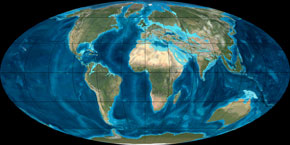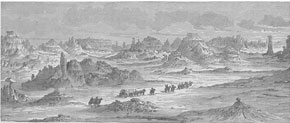Interval 2
Interval 2 – The Earth Cools

A landscape about 32 million years ago, in what is now the northern Great Plains at Badlands National Park, South Dakota.. The forest, primarily mixed deciduous trees and conifers, is confined to the vicinity of the stream and nearby floodplain. A group of early horses is being stalked by Hoplophoneus, a saber-toothed nimravid carnivore. AMNH.
At the beginning of the Eocene, Australia and Antarctica were connected together. This meant that warm equatorial ocean currents mixed with colder Antarctic waters, distributing heat around the planet and keeping global temperatures relatively high. But when Australia split from the southern continent around 45 MYA, the warm equatorial currents were deflected away from Antarctica, and an isolated cold water channel developed between the two continents. The Antarctic region cooled down, and the ocean surrounding Antarctica began to freeze, sending cold water and ice floes north, reinforcing the cooling. As the Antarctic continent grew cooler, an ice cap started to form, drawing water from the atmosphere and lowering global humidity.
Could a Fern have Caused Global Cooling?
The isolation of Antarctica may not have been the only factor in the Middle Eocene leading to global cooling. Beneath the bed of the Arctic Ocean, scientists have discovered an 8 meter deep layer of sedimentary rock that is made up of fossils of an aquatic fern called Azolla. This layer dates back to around 49 MYA, about the time that the Earth’s cooling trend began. The thickness of the layer suggests that that massive blooms of Azolla were occurring in the Arctic Ocean in the Middle Eocene. At this time, the Arctic was largely cut-off from the wider oceans – mixing of water was limited, and the lower layers of Arctic basin were stagnant. Dead Azolla plants sinking to the bottom would not rot in these anoxic conditions, but would be buried in sediment, trapping the carbon dioxide the plants had absorbed while they were alive. The end result would be a draw down of carbon dioxide from the atmosphere, accelerating the cooling of the planet.
The climate became more seasonal, although the world was still much warmer than it is today. With the changing climate, the tropical rainforests that had once dominated North America began to give way to more open habitats. By the late Eocene, partially-wooded habitats had appeared and the first grasslands were forming in the Western part of the continent. It is possible that late Eocene perissodactyls like the early horse Mesohippus had begun to graze in these grasslands. Their teeth show wear patterns that may be evidence for a grass eating diet. But they still lacked the specialized dental adaptations of true grazers.
In the latter part of the Eocene, many of the archaic groups of mammals (i.e. those with no living relatives) began to go extinct. Mammals that survived and prospered during the later Eocene and Oligocene did so by adapting to the changing environment. As forests gave way to more open terrain, body size increased; some perissodactyls, such as Embolotherium and Indricotherium, evolved to tremendous sizes. Another important set of adaptations was related to cursoriality – the evolution of body plans related to running, such as lengthened legs, fusion of limb and ankle bones, and reduction in toe number. In open country, the ability to run serves two purposes – it allows animals to escape from predators, but it also improves their ability to travel long distances in search of food. For herbivores living in a seasonal climate, where rainfall and plant growth may vary from place to place at different times, this is extremely important.
The First Grasslands
The first grasses evolved at the end of the Cretaceous but they only began to diversify significantly in the Eocene and Oligocene. Today, grasslands account for around 31% of the Earth’s land surface. Grasses present particular challenges for herbivores – they are rich in silica, which makes them tough to digest and increases wear on the molar teeth. But because they grow from the base of their leaf blades, rather than the tips, they can withstand heavy grazing without being severely damaged. This makes them a valuable food resource for mammals that can evolve the necessary dental and digestive adaptations. The evolution of large grazing mammals may have had a positive feedback effect on the spread of grasslands. Areas cleared by fire are rapidly colonized by grasses, but in the absence of grazers, tree seedlings grow up and produce shade, which eventually kills most grasses. Large animals trample the seedlings, killing the trees. Grasses lack woody stems, which helps them to resist damage from trampling.
In the early Oligocene there was another period of severe global cooling. Many perissodactyls became extinct during this period, including the brontotheres, palaeotheres, and hyracodontids. Amynodontids went extinct later in the Oligocene. The surviving perissodactyl groups – the rhinos, horses, tapirs, and chalicotheres were better adapted to a cooler, drier world, dominated by grasses.
Indricotherium; an Oligocene Giant
Indricotherium was a gigantic perissodactyl, distantly related to today’s rhinos. Unlike a modern rhino it was hornless and long-legged. It is the largest land mammal known: an adult Indricotherium would have been16 to 18 ft tall at the shoulder, over 26 ft in length (not including the tail), and capable of raising its head 25 ft above the ground. Its skull alone was over 4 ft in length. Estimates of its weight vary greatly, but are in the range of 10 to 20 (metric) tons, the size of a medium sauropod dinosaur. It is thought to have fed by stripping leaves from trees with its down-pointing, tusk-like upper teeth, which occluded with forward-pointing lower teeth. The first specimens of Indricotherium were discovered by AMNH’s Central Asiatic Expedition in the Gobi Desert of Mongolia. Today this is an arid environment with huge seasonal fluctuations in temperature, but when Indricotherium was alive, roughly from 30 to 20 million years ago, this region of Asia was covered in lush subtropical forests and woodlands.
The White River Badlands
The White River is a major tributary of the Missouri River that flows through Western Nebraska and South Dakota. In its western stretches it passes through a region of grass prairie interspersed with sharply eroded buttes, pinnacles, and rock spires that spreads across Nebraska, South Dakota, and Wyoming. In the Lakota language of the Sioux such terrain was known as mako sica – literally “bad land” – because of the rough terrain and lack of water. Nonetheless, these are some of the richest fossil deposits in the world. According to the National Park Service, the rock in this area erodes at an average at an average rate of 1 inch per year, meaning that new fossils are always being exposed. The rock strata in the White River Badlands span an enormous time range, from the late Cretaceous through to the Pliocene, but the region is probably best known for its extraordinary assemblage of Oligocene mammals. This includes many kinds of perissodactyl, including the running rhino Hyracodon, the semi-aquatic Metamynodon, the early rhino Subhyracodon, and the 3-toed horse Mesohippus. Earlier strata, from the Eocene, have abundant remains of the brontotheres Brontops and Brontotherium, while the later Miocene deposits contain fossils of the chalicotheres Moropus. Some of the finest fossils in the AMNH collections come from the White River Badlands and much of our knowledge of mammal evolution in the Oligocene is based of the study of its fossil fauna.


Left: Reconstructed skeleton and body outline of Indricotherium with human for scale. Actual bonescollected are shaded. AMNH. Right: A life-size model of the giant Oligocene hyracodont rhino Indricotherium from AMNH’s “Extreme Mammals” exhibit. Roderick Mickens\AMNH.







